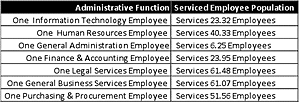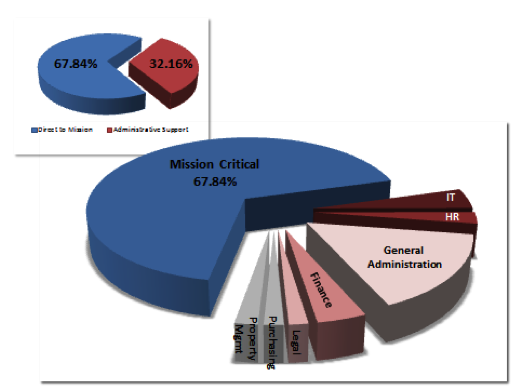Office of Personnel Management Director John Berry said in 2009 that he would work with the Department of the Interior and the General Services Administration to create a set of model programs for employees who work at the three agencies' headquarters to "turn the three workplaces into a 'utopia' within 12 months."
Utopia? Really? Setting aside, for the moment, the "Let them eat cake" message this sent to millions of anxious taxpayers, not to mention the millions of unemployed and underemployed, what would a utopia look like for federal workers?
Would it be a world where the government hired one administrative staffer to support every 6.25 employees? Or at least one information technology specialist for every 23 employees? Or perhaps one human resources staffer for every 40 employees?
At a time when the private sector has trimmed every expense possible to live within its means, the government has managed to do the opposite. More than 32 percent of every payroll dollar in the federal government's Cabinet level agencies went to pay for administrative personnel in 2010. And the remaining 68 percent was supposed to complete the mission.
If you were the President of the United States and this is the state of your major business units, these Cabinet level agencies, would you try to cut overhead in order to save important program dollars from hitting the ax? Wouldn't it be more important to cut overhead expense rates than cut services provided to the very taxpayers whose working lives are very, very, far from the utopian construct Mr. Berry envisions?
 Here are statistics from federal Cabinet level agencies that illuminate the issue. Using a concept called servicing ratio, which is the number of mission-direct employees that are supported by a single employee in an administrative (indirect) role, you start to see the extent of the problem. The table to the right illustrates the servicing ratio in each of the indirect functions performed by in-house, federal employees -- beginning with one information technology specialist for every 23.34 direct employees. And it doesn't end there. In each of these functions, there is a sizable underlying contractor support system that totals billions of taxpayer dollars in contracts.
Here are statistics from federal Cabinet level agencies that illuminate the issue. Using a concept called servicing ratio, which is the number of mission-direct employees that are supported by a single employee in an administrative (indirect) role, you start to see the extent of the problem. The table to the right illustrates the servicing ratio in each of the indirect functions performed by in-house, federal employees -- beginning with one information technology specialist for every 23.34 direct employees. And it doesn't end there. In each of these functions, there is a sizable underlying contractor support system that totals billions of taxpayer dollars in contracts.
The next time you hear about the lone air traffic controller falling asleep on the midnight shift, think about this: The FAA has one administrative staffer for every 3.5 FAA employees -- and one for every 1.5 air traffic controllers -- a full 28 percent of its staff in administrative occupations.
If you're in the private sector, you've dropped your jaw on this one. The last time you saw this kind of overhead was in the 1950s -- before technology started to overtake manual, labor-intensive business functions. Even if you sent work off-shore, your company still depended on technology to be the real force multiplier. Without technology, manufacturing, farming, energy, retail, and virtually every other industry would be developing cost-prohibitive products -- and out of business.
Where technology overtook an entire industry, like newspapers, draconian cost-cutting measures have taken hold in an attempt to live within the scope of revenue and whatever market share remains. Robotics and technology-enabled labor greatly reduced jobs in certain industries, and certain occupations became obsolete because employees had desktop or mobile access to the information and tools needed to do the job.
How has the government managed to escape this trend?
Organizations with external accountability are constantly examining efficiency levels. In charitable organizations, there is the 80-20 rule. To be considered effective at distribution of funds, a nonprofit is expected to disperse 80 percent of charitable contributions directly to the intended beneficiary while retaining 20 percent to cover operating costs or overhead.
In business, the pressure is even more direct. Profitability is the only measure of success in business. Profitability signals health and internal efficiency. In government, success is measured by the size of your budget and workforce. The government scales with people instead of technology - and that is the underlying reason government is expensive.

Government never learned the lessons of more successful organizations. There is no real measure of efficiency. But the real story is in the slow and creeping invasion of value leaks throughout government. Let's take the metric described above -- what is the proportion of direct to mission versus indirect costs to sustain the government. The federal Cabinet level agencies have a direct-to-indirect payroll ratio of 67.84 percent to 32.16 percent -- that is, 68 percent of payroll supports the people working on the agency's core mission while 32 percent of payroll is engaged in mission support or administrative work.
For Cabinet level agencies, an estimated $45 billion a year is spent on payroll for administrative personnel (yes, that's $45 BILLION). And that's before you get to what they're spending on contractors or intergovernmental shared-service agreement for the same functions -- like a whopping $5.5 billion on human resources alone.
In the private sector, general and administrative (G&A) expense for organizations with $1 billion-plus in revenue averages 7.6 percent. In smaller organizations, it can average as much as 14.2 percent. But government's G&A approaching 32 percent screams inefficiency. It is a flashing red light signaling an unhealthy and wasteful infrastructure.
The government's employment growth rate (compound annual growth rate, or CAGR), measuring a decade of employment statistics, equals 11.2 percent. It's CAGR for administrative personnel keeps pace at a steady 9.36 percent. Growth of administrative personnel is in lock-step with that of mission-direct personnel.
If the country goes to war or has an economic crisis or needs to distribute emergency supplies in a national disaster, its response is always the same, hire more people to meet that new need.
American Recovery and Reinvestment Act funding is a good example. Because the funding went through the federal government instead of directly to recipients, overhead had to grow along with mission headcount to distribute the funds. The level of investment it takes to grow headcount before mission execution bogs down the delivery of funds -- and it siphons money from the beneficiary as those funds wind through the system.
Curing administrative overload is not an insoluble problem. It isn't even particularly difficult. The government needs to be mandated to scale with technology -- instead of people -- and redistribute scarce tax dollars direct to agency missions.
Some of you reading this may be in government. If you are, ask yourself: Am I really getting personalized service from these folks? When I call my IT shop, do they send someone immediately to help me with my problem or is there a waiting list? If I call my IT shop, do I get a contractor instead of an agency employee? How big is the contractor workforce supporting my own IT people? What does that cost?
Linda E. Brooks Rix is co-CEO of Avue Technologies, a public sector human capital management solutions platform provider headquartered in Tacoma, Wash., and offices in Washington, D.C. Avue's flagship solution, Avue Digital Services® has been a "Level 4" fully hosted solution that has been in production since 2001 with a 99+% uptime.